LAB REPORT
Science and Technology Making Headlines
July 21, 2017

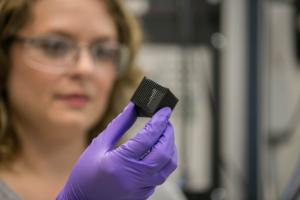
Lab researcher Jennifer Rodriguez examines a 3D printed box that was "programmed" to fold and unfold when heated.
Go directly to 4D
A research team from Lawrence Livermore has used a direct ink writing process to 3D print property-specific, silicone metamaterials that possess shape-memory behavior, which technically makes them 4D printed. LLNL has worked with both 3D-printed metamaterials and 4D printing before, but by using the direct ink writing process, the material becomes more lightweight and functional, with a tailored, mechanical response.
This can be achieved when printed structural porosity and intrastrand porosity are combined, by adding hollow, gas-filled microspheres into the 3D printing ink. Many researchers are adding different materials to the mix, such as these shape-memory polymers, to increase the potential applications.
Direct ink writing enables the layer-by-layer manufacture of ordered, porous structures whose mechanical behavior is driven by architecture and material properties.

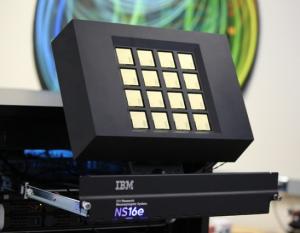
Lawrence Livermore received the 16-chip IBM TrueNorth platform late last year.
Computing on the brain
Updating all the geometric facets of a moving object at once is a problem similar to calculating all the outputs from a given neural net layer at once. But the hardware was not designed to perform deep learning as efficiently as a brain, which can drive a car and simultaneously carry on a conversation about the future of autonomous vehicles, all while using fewer watts than a lightbulb.
In a traditional computer, a processing unit continually fetches information from separate memory areas, performs operations on it and then returns the new information to memory when it’s done, leading to a lot of slow and wasteful communication.
But brain-inspired computers, such as TrueNorth at Lawrence Livermore, can process the equivalent of 16 million neurons and 4 billion synapses and consume the energy equivalent of a hearing-aid battery -- a mere 2.5 watts of power.
The brain-like, neural network design of the IBM Neuromorphic System is able to infer complex cognitive tasks such as pattern recognition and integrated sensory processing far more efficiently than conventional chips.

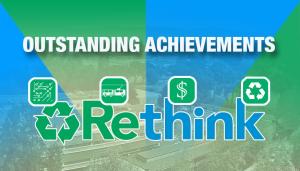
Lawrence Livermore is one of five Bay Area federal facilities recognized for improving efficiency, saving resources and reducing costs as part of the Federal Green Challenge and "Changing How We Think About Our Resources.”
Going green
Lawrence Livermore National Laboratory is one of five Bay Area federal facilities recognized for improving efficiency, saving resources and reducing costs as part of the Federal Green Challenge (FGC).
LLNL has participated in the FGC since its inception in 2011, achieving reductions in municipal waste, sustainable purchasing, sustainable electronics and transportation categories. This is the first year that LLNL has been recognized at the regional level, for outstanding achievements in sustainable purchasing.
LLNL has made steady incremental reductions in office paper usage since 2009 through initiatives such as managed print services, double-sided printing and moving to email report submittals and electronic approvals. All of this adds up to substantial savings ($85,000 annually) and an overall reduction in paper purchases of more than 40 percent. In addition to the savings associated with purchasing more than 22,300 reams (56 tons) less paper, there are even bigger savings associated with ink and toner cartridges purchases -- $500,000 a year.

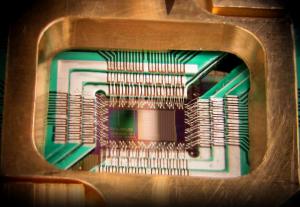
Companies like Google are considering turning quantum computing into a business residing on the cloud.
Head in the cloud
For years, Google has poured time and money into building a working quantum computer. Now the company is thinking of ways to turn the project into a business.
Google has offered science labs and artificial intelligence researchers early access to its quantum machines over the internet in recent months. The goal is to spur development of tools and applications for the technology, and ultimately turn it into a faster, more powerful cloud-computing service, according to people pitched on the plan.
Jonathan DuBois, a scientist at Lawrence Livermore National Laboratory, said Google staffers have been clear about plans to open up the quantum machinery through its cloud service and have pledged that government and academic researchers would get free access.

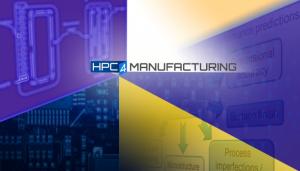
A Department of Energy program designed to spur the use of high performance supercomputers to advance U.S. manufacturing is seeking industry proposals.
We got the power
The Department of Energy’s (DOE) High Performance Computing for Manufacturing Program (HPC4Mfg), designed to spur the use of national lab supercomputing resources and expertise to advance innovation in energy efficient manufacturing, is seeking a new round of proposals from industry to compete for $3 million.
Since its inception, HPC4Mfg has supported projects partnering manufacturing industry members with DOE national labs to use laboratory HPC systems and expertise to upgrade their manufacturing processes and bring new clean energy technologies to market. This is the fourth round of funding for this rapidly growing program.
The partnerships use world-class supercomputers and the science and technology expertise resident at the national laboratories, including Lawrence Livermore National Laboratory, which leads the program with principal partners Lawrence Berkeley and Oak Ridge national laboratories and other participating laboratories. An HPC expert at each lab teams up with U.S. manufacturers on solutions to address challenges that could result in advancing clean energy technology.





